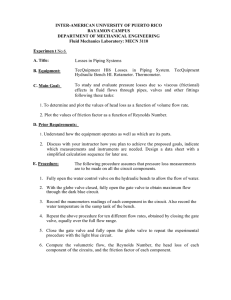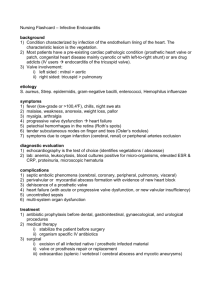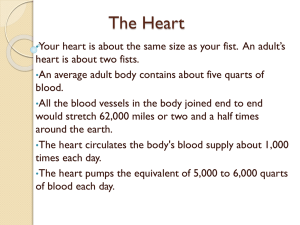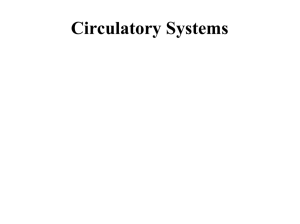(ie plot graphs of head loss (∆h) against dynamic head (, and the
advertisement
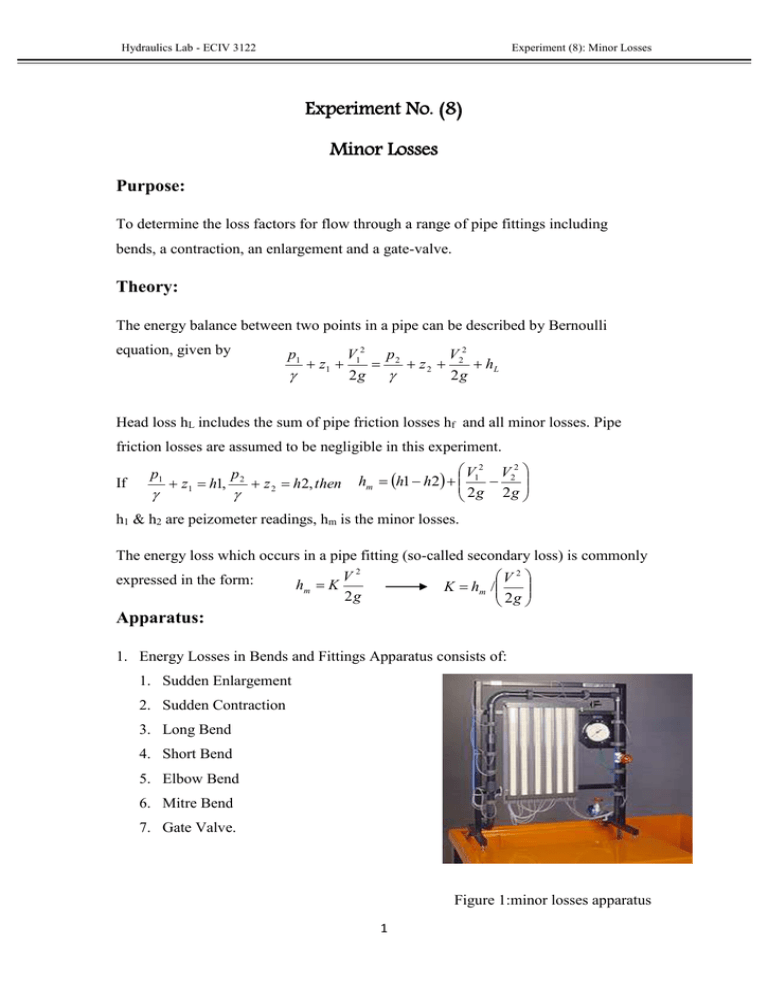
Hydraulics Lab - ECIV 3122 Experiment (8): Minor Losses Experiment No. (8) Minor Losses Purpose: To determine the loss factors for flow through a range of pipe fittings including bends, a contraction, an enlargement and a gate-valve. Theory: The energy balance between two points in a pipe can be described by Bernoulli equation, given by V12 p 2 V22 z1 z2 hL 2g 2g p1 Head loss hL includes the sum of pipe friction losses hf and all minor losses. Pipe friction losses are assumed to be negligible in this experiment. If p1 z1 h1, p2 z 2 h2, then V 2 V 2 hm h1 h2 1 2 2g 2g h1 & h2 are peizometer readings, hm is the minor losses. The energy loss which occurs in a pipe fitting (so-called secondary loss) is commonly V2 V 2 expressed in the form: hm K K hm / 2g 2g Apparatus: 1. Energy Losses in Bends and Fittings Apparatus consists of: 1. Sudden Enlargement 2. Sudden Contraction 3. Long Bend 4. Short Bend 5. Elbow Bend 6. Mitre Bend 7. Gate Valve. Figure 1:minor losses apparatus 1 Hydraulics Lab - ECIV 3122 Experiment (8): Minor Losses 2. The following dimensions from the equipment are used in the appropriate calculations. Internal diameter of pipe: d = 0.0183 m Internal diameter of pipe at enlargement outlet and contraction inlet : d = 0.0240 m 3. For the gate valve experiment, pressure difference before and after gate is measured directly using a pressure gauge. This can then be converted to an equivalent head loss using the equation: 1 bar = 10.2 m water Procedure: It is not possible to make measurements on all fittings simultaneously and, therefore, it is necessary to run two separate tests. PART (A) 1. Set up the losses apparatus on the hydraulic bench so that its base is horizontal by adjusting the feet on the base plate if necessary. (this is necessary for accurate height measurements from the manometers). Connect the test rig inlet to the bench flow supply and run the outlet extension tube to the volumetric tank and secure it in place. 2. Fully open the gate valve and the outlet flow control valve at the right hand end of the apparatus. 3. Close the bench flow control valve then start the service pump. 4. Gradually open the bench flow control valve and allow the pipework to fill with water until all air has been expelled from the pipework. 5. In order to bleed air from pressure tapping points and the manometers close both the bench valve and the test rig flow control valve and open the air bleed screw and remove the cap from the adjacent air valve. Connect a length of small bore tubing from the air valve to the volumetric tank. Now, open the bench valve and allow flow through the manometers to purge all air from them; then, tighten the air bleed screw and partly open both the bench valve and the test rig flow control valve. 2 Hydraulics Lab - ECIV 3122 Experiment (8): Minor Losses Next, open the air bleed screw slightly to allow air to enter the top of the manometers, re-tighten the screw when the manometer levels reach a convenient height. 6. Check that all manometer levels are on scale at the maximum volume flow rate required (approximately 17 liters/ minute). These levels can be adjusted further by using the air bleed screw and the hand pump supplies. The air bleed screw controls the air flow through the air valve, so when using the hand pump, the bleed screw must be open. To retain the hand pump pressure in the system, the screw must be closed after pumping. 7. If the levels in the manometer are too high then the hand pump can be used to pressurise the top manifold. All levels will decrease simultaneously but retain the appropriate differentials. If the levels are too low then the hand pump should be disconnected and the air bleed screw opened briefly to reduce the pressure in the top manifold. Alternatively the outlet flow control valve can be closed to raise the static pressure in the system which will raise all levels simultaneously. If the level in any manometer tube is allowed to drop too low then air will enter the bottom manifold. If the level in any manometer tube is too high then water will enter the top manifold and flow into adjacent tubes. 8. Adjust the flow from the bench control valve and, at a given flow rate, take height readings from all of the manometers after the levels have steadied. In order to determine the volume flow rate, you should carry out a timed volume collection using the volumetric tank. This is achieved by closing the ball valve and measuring (with a stopwatch) time taken to accumulate a known volume of fluid in the tank, which is read from the sight glass. You should collect fluid for at least one minute to minimize timing errors. ( note: valve should be kept fully open.) 9. Repeat this procedure to give a total of at least five sets of measurements over a flow range from approximately 8 - 17 liters per minute. 3 Hydraulics Lab - ECIV 3122 Experiment (8): Minor Losses PART (B) 10. Clamp off the connecting tubes to the mitre bend pressure tappings (to prevent air being drawn into the system). 11. Start with the gate valve closed and open fully both the bench valve and the lest rig flow control valve. 12. open the gate valve by approximately 50% of one turn (after taking up any backlash). 13. For each of at least 5 flow rates, measure pressure drop across the valve from the pressure gauge; adjust the flow rate by use of the test rig flow control valve. Once measurements have started, do not adjust the gale valve. Determine the volume flow rate by timed collection. 14. Repeat this procedure for the gate valve opened by approximately 70% of one turn and then approximately 80% of one turn. Data and results: Table 1. Raw Data for All Fittings Except Gate Valve Case No. Volume Time Piezometer Readings (mm) Enlargement Contraction Long Bend Short Bend Elbow Mitre Bend (L) (sec) 1 2 3 4 5 6 7 8 9 10 11 12 I 13 95.93 243 248 247 237 246 244.5 237 228 220 206 190 171 II 13 75.8 255 263 262 245 259 256 245 231 220 198 175 145 4 III 21 107.06 265 275 274 253 272 267 253 234 219 191 162 122 IV 24 108.53 276 289 287 260 284 279 260 237 219 183 147 98 V 25 93.14 299 319 317 276 309 301 277 243 217 165 115 43 Hydraulics Lab - ECIV 3122 Experiment (8): Minor Losses 80% Opened 70% Opened 50% Opened Table 2. Raw Data for Gate Valve Case No. Volume (L) Time (sec) Gauge Reading (bar) I 40 84.12 II 25 61.21 III 24 67.02 IV 19 63.49 V 14 65.22 Red (upstream) 1.1 0.79 0.6 0.4 0.2 Black (downstream) 0.09 0.05 0.01 0 0 40 57.53 40 68.04 35 65.39 30 64.9 25 71.4 Red (upstream) 0.4 0.3 0.23 0.16 0.09 Black (downstream) 0.02 0.01 0 0 0 40 55.45 40 61.39 40 67.31 40 83.97 40 96.78 Red (upstream) 0.2 0.17 0.11 0.08 0.03 Black (downstream) 0.07 0.05 0.02 0 0 Volume (L) Time (sec) Gauge Reading (bar) Volume (L) Time (sec) Gauge Reading (bar) Calculations: Table 3. Minor Head Losses of All Fittings Except Gate Valve Case No. I II Q (m3/sec) V (m/s) V2/2g (m) Minor Head Losses (m) Enlargement Δh Δh +V12/2g- V22/2g Contraction Δh Δh +V12/2g- V22/2g Long Bend Short Bend Elbow Mitre Bend 5 III IV V Hydraulics Lab - ECIV 3122 Experiment (8): Minor Losses Table 4. Loss Coefficients for All Fittings Except Gate Valve Case No. I II III IV V Loss Coefficients Q (m3/sec) V (m/s) V2/2g (m) Enlargement Contraction Long Bend Short Bend Elbow Mitre Bend 80% Opened 70% Opened 50% Opened Table 5. Equivalent Minor Head Loss and Loss Coefficient for Gate Valve Case No. Q (m3/sec) V (m/sec) I II V2/2g (m) Minor Head Loss (m) Loss Coefficient Q (m3/sec) V (m/sec) V2/2g (m) Minor Head Loss (m) Loss Coefficient Q (m3/sec) V (m/sec) V2/2g (m) Minor Head Loss (m) Loss Coefficient 6 III IV V Hydraulics Lab - ECIV 3122 Experiment (8): Minor Losses Questions .. 1. For Part A, prepare plots that show the effect of dynamic head on minor head loss V2 (i.e. plot graphs of head loss (∆h) against dynamic head ( 2g)), and the effect of flow rate on loss coefficients (i.e. K against volume flow rate Q). 2. For Part B, prepare plots that show the effect of dynamic head on equivalent head V2 loss (i.e. (∆h) against ( 2g)), and the effect of flow rate on loss coefficients (i.e. K against volume flow rate Q). 3. Comment on and explain previous relationships. a. Is it justifiable to treat the loss coefficient as constant for a given fitting? Explain. b. How does the loss coefficient for the gate valve vary with the extent of the opening of the valve? Explain. 4. Does the static pressure increase or decrease for the enlargement and contraction? Explain the increase or decrease in static pressure. 7
